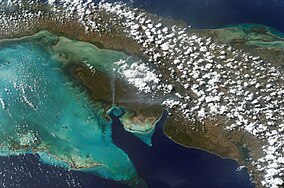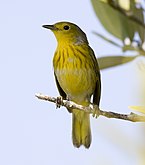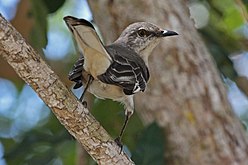Zapata Swamp
| Ciénaga de Zapata | |
|---|---|
 Zapata Swamp as seen from space. South is towards the top. | |
Location of Ciénaga de Zapata in Cuba | |
| Location | |
| Nearest city | Playa Larga Jagüey Grande |
| Coordinates | 22°24′N 81°34′W / 22.400°N 81.567°W |
| Area | 4,354.3 km2 (1,681.2 sq mi)[1] |
| Official name | Ciénaga de Zapata |
| Designated | 12 April 2001 |
| Reference no. | 1062[2] |
The Zapata Swamp (Spanish: Ciénaga de Zapata, Spanish pronunciation: [ˈsjenaɣa ðe saˈpata]) is located on the Zapata Peninsula in the southern Matanzas Province of Cuba, in the municipality of Ciénaga de Zapata. It is located less than 150 kilometres (93 mi) southeast of Havana.[11]
Species and preservation
Within the Zapata Swamp are over 900 autochthonous plant species, 175 species of birds, 31 species of reptiles and over 1000 species of invertebrates. Some of the most notable are local endemics to Cuba; for birds, it includes the Zapata wren, Zapata rail, and the Zapata sparrow.[6] The Zapata Swamp is also a particular habitat of the Bee hummingbird, the smallest bird species on the planet.[12] The Zapata Swamp is also visited by 65 species of birds during their migration pattern from North America through the Caribbean to South America. Zapata is also known for the local endemic Cuban crocodile (Crocodylus rhombifer) which are restricted to the Zapata Swamp and are being reintroduced to the nearby Lanier Swamp on the Isle of Youth (Spanish: Isla de la Juventud).[3][5][13]

Within the Zapata Swamp are numerous areas designated for environmental preservation, such as Zapata Swamp Natural Reserve and Las Salinas wildlife sanctuary, which is part of the larger Ciénaga de Zapata Biosphere Reserve (IUCN category VI) which in total is over 6,000 km² and the largest protected area, not only in Cuba, but also the Caribbean.[8][9] The swamp is not only known for its size but also for being the best preserved wetlands in all of the Antilles, designated as a "Wetland of International Importance" by the Ramsar Convention on Wetlands in 1971.[14] In mid-2001 an additional 4,520 km² were declared a Ramsar Site in mid-2001.[10][15]
Geography
The Zapata Swamp lies between 22°01’ and 22°40’ N latitude and between 80°33’ and 82°09’ W longitude. The swamp in total is over one million acres (4,000 km²).[4] Topographically, the maximum height above sea level is only about 10 meters with the top depth in below-sea-level coastal zones as follows: 2 meters in the salt-marsh area and from 1–600 meters in the sea coastal zone. Between May and October, the warmest season of the year, average temperature is 30 °C (86 °F). Between November and April, the coldest season of the year, the temperature on average is 20 °C (68 °F).[9][10][13][16]
Gallery
-
American flamingos in Zapata
-
Crocodile farm in Zapata
-
A Yellow Warbler in Zapata
-
Cuban Brown Curlytail in Zapata
-
Northern Mockingbird in Zapata
-
Eastern Giant Toad
See also
- Ernst Thälmann Island
- Geography of Cuba
- Protected area
- Ramsar Convention
- World Conservation Monitoring Centre
References
- ^ National Protected Areas System of Cuba. "Protected Areas". Archived from the original on 2007-08-10. Retrieved 2007-10-10.
- ^ "Ciénaga de Zapata". Ramsar Sites Information Service. Retrieved 25 April 2018.
- ^ a b Friends of the National Zoo. "Cuban Crocodile". Smithsonian National Zoological Park.
- ^ a b Jordan Levinson. "WTA Partners Pioneer Efforts In Cuban Wetland Conservation". Wildlife Trust.
- ^ a b Brian Simpson. "Ecotourism in Cuba". Smithsonian National Zoological Park.
- ^ a b "Cuba: Wild Island of the Caribbean". PBS.
- ^ "Cuban wetlands". Terrestrial Ecoregions. World Wildlife Fund.
- ^ a b Steve Winter. "Cuba's Wild Side".
- ^ a b c United Nations Environment Programme - World Conservation Monitoring Centre. "World Database on Protected Areas".
- ^ a b c United Nations Environment Programme - World Conservation Monitoring Centre. "World Database on Protected Areas: Ramsar".
- ^ [3][4][5][6][7][8][9][10]
- ^ Garrido, O. H., & A. Kirkconnell. 2000. Field guide to the birds of Cuba. Cornell Univ. Press, New York, New York, USA
- ^ a b "Cuba: Ciénaga de Zapata National Park". UNESCO. February 28, 2003.
- ^ Stefan Lovgren (August 4, 2006). "Castro the Conservationist? By Default or Design, Cuba Largely Pristine". National Geographic News.
- ^ "Zapata Swamp". Cuba Vintage Vacation. Retrieved 2020-03-06.
- ^ "Zapata Swamp - Cuba's Wet and Wild Side". Zegrahm Expeditions. Retrieved 2020-03-06.
Sources
This section is empty. You can help by adding to it. (May 2019) |
External links
 Media related to Zapata Swamp at Wikimedia Commons
Media related to Zapata Swamp at Wikimedia Commons- cubatechtravel.com, Areas of Natural Interes, Beaches, Nature Trails







